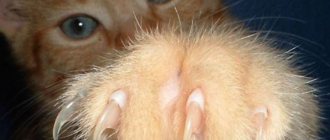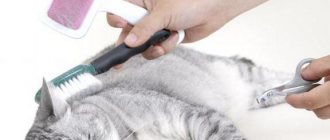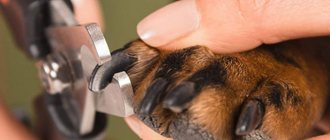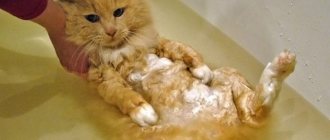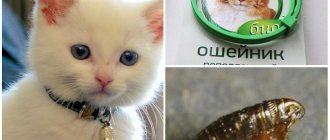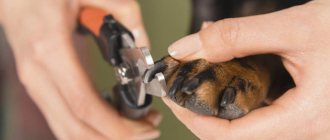How to avoid problems with your pet? And we are not talking about cat litter at all from a hygiene point of view. Although, if you think about it, it’s just about the toilet. Nail, so to speak.
While the kitten is small, it does not understand that it is releasing its claws and causing pain to its owner by scratching his hands. Or that you shouldn’t tear up walls, furniture and clothes - these are not things for “scratching your claws.” Therefore, it will be easiest to trim your pet’s nails. At what age can a kitten’s claws be trimmed? Is it necessary to do it at all? We'll tell you in more detail below.
Why does a kitten need nails?
It’s clear why cats living outside need claws. And to escape from danger, and to feed. Why does a pet need them? He doesn't leave the apartment. And he has no idea what hunting is. Maybe you shouldn’t bother with the question of at what age can a kitten’s nails be trimmed? How about taking the baby to the veterinary clinic and getting rid of this sharp weapon?
So we get to the main idea. Claws are a cat's weapon. They are also compared to human fingers. It is the claws that help animals sense balance and play an important role in the pet’s spatial orientation. It has long been known that cats that are deprived of this important addition to their paws become “crippled.” Their musculoskeletal system is impaired.
At what age can you start cutting a cat's nails?
Having decided to have a small kitten at home, you must be prepared for the fact that he will scratch: furniture, wallpaper, sofas and armchairs.
To prevent this from happening, you need to know at what age to trim a kitten’s claws. A small cat scratches everything around because of its natural instinct. He does not understand that this is bad and cannot be done this way. Thus, the baby even marks his territory. To avoid damage to your property, you need to periodically trim your pet's claws.
Removal
At what age can a kitten's nails be trimmed? How should an adult cat cut them? Do you need to go to the clinic every time? At home, on your own? No, your hand won't rise. We'll have to carry it. And this will take time. Remove these claws once and for all. Moreover, why does the cat need them? Should I sit at home with my claws? Only the sofa spoils the wallpaper, he ignores the scratching post, he’s a bad creature. This is a bunch of questions swirling around in the owners’ heads.
The owner loves his animal and wants to do the best for everyone. It would be nice to rid the kitten of its claws, as it doesn’t seem to need them at all. And yourself - from problems with damage from these very claws. Just before taking your pet for surgery to remove them, you need to think several times. Is it worth it?
As mentioned above, in animals without claws the functioning of the musculoskeletal system is impaired. And that is not all. A cat, deprived of its main support and tool for protection, experiences extreme stress. Once outside, such an animal will die immediately. He has no chance of salvation.
Here the emphasis has been long and persistently placed on the musculoskeletal system. Someone will be surprised what claws have to do with it. The thing is that during the declawing operation, the phalanges of the cat’s fingers are cut off. Imagine that a person has been partially deprived of his toes. How will he walk after this? And now it becomes clear what it’s like for the cat.
At what age can you start trimming a kitten's nails?
You can start trimming kittens' claws from 1 month, when kittens begin to move and play independently. At this age, their claws are very sharp and it is necessary to trim them so that they do not injure each other while playing.
A friend had a case when the kittens scratched each other’s eyes, one kitten developed a thorn. The thorn went away, but it took a whole year of treatment and a lot of money for medicine
Therefore, you can trim the claws of kittens and adult cats. You just need to do this very carefully and correctly and with special nail clippers, so as not to damage the living part of the claw (pulp) and not cause an infection.
Claw clippers look like this:
But your pet should also have a scratching post. It is necessary to sharpen your cat's claws. They carry out this procedure so that the old claws come off and new ones grow. The cat also sharpens its claws and relieves stress, while at the same time leaving territorial marks.
Especially now there is such a huge selection of scratching posts at different prices)
A friend had a case when the kittens scratched each other’s eyes, one kitten developed a thorn. The thorn went away, but it took a whole year of treatment and a lot of money for medicine
Nail trimming and breed
At what age can you cut the nails of a Scottish, Siamese or Persian kitten? In fact, nothing depends on the breed here. It all depends on the age of the animal. Claws are formed in felines by the age of 4-6 months. It is during this period of time that owners begin to prune them.
Do I need to take my pet to the veterinary clinic for this? If the owner is very afraid to perform the procedure on his own, then it is possible. But there is nothing complicated about this manipulation. Below we will tell you in detail how to trim your pet's claws.
How often and from how many months can kittens have their nails trimmed?
The kitten needs to have its nails trimmed. This is a painless procedure that will not harm the animal. Trimming claws is a necessary manipulation that guarantees the safety of interior items. But carrying out the procedure at home requires appropriate knowledge, without which there is a high probability of harming the kitten.
You can often hear from animal rights activists that such a measure is very harsh, but this point of view is not supported by facts, only by emotions. There are several reasons why it is necessary to shorten your pet’s claws, among the most significant are:
- damage to furniture, wallpaper, curtains, bedding, carpets, tablecloths, etc.;
- harming oneself or other kittens during play;
- Potentially dangerous for small children.
We recommend reading: Inflammation of the Fallopian Tubes in Dogs
It is worth remembering that cats who spend their leisure time outside do not need this procedure, since they independently wear them down on hard tree bark and the walls of wooden buildings.
During the cutting process, it is strictly forbidden to cut off the part of the claw in the area of the pulp - the plexuses of blood vessels that constitute the “living” part of the claw. This will cause bleeding, pain, and sometimes infection. To avoid unpleasant developments, the cut line should be at least 2-3 millimeters from the pulp.
The first keratinized elements on the paws of a furry friend are formed by 4-8 weeks of life, but it is worth doing a “manicure” only if the cat is likely to self-traumatize, since the growths still have a relatively fragile structure and, by and large, do no harm.
Strong and strong claws appear in the animal from about 4-6 months of age (depending on nutritional characteristics and health status). Often it is during this period that the owners begin to trim the kitten’s claws.
It is very important not to forget about the pet’s state of mind at the time of removing sharp ends: you need to stroke and calm the fluffy while cutting. If he actively resists, it is recommended to carefully wrap the cat in thick material, stick the necessary paw out and begin to act. At this time, it is worth keeping hydrogen peroxide or alcohol on hand, which can be used in case of accidental injury to the animal or its owner.
Some information sources talk about the need to reward a restless pet with some kind of treat after the end of an unpleasant process for him. Such a measure will avoid breaking the trust relationship between a person and his younger brother.
Since it takes approximately 25-35 days to fully restore the claws after the next cat manicure session, the norm would be to trim or polish once a month.
During the process, many owners forget about the presence of a fifth claw on the front legs, which most often causes domestic cats discomfort when they grow into the paw pads. These vestigial growths are located slightly higher than the others and grow much faster: they must be taken special care of.
Contrary to popular belief, under no circumstances should you perform a haircut using ordinary scissors or a nail clipper intended for humans. The accessories in question are not adapted to the unique shape of a kitten's claws. Their use is fraught with serious consequences for the health of your furry friend.
Specialized stores sell special items that, if possible, are recommended for every owner to purchase. There are 4 main types of convenient devices:
| Item name | Appearance | Average cost in rubles |
| nail clipper | Miniature semicircular guillotine on a spring | 180-300 |
| Tweezers | Something between a pruner and pliers | 225-400 |
| Scissors | Regular small scissors with a crescent-shaped edge on both blades | 120-235 |
| Grinder | Round rotating polishing element attached to a comfortable handle base (usually used by professional veterinarians) | 1250-2100 |
In addition to the basic tools, you should consider buying or making a nail sharpener, which can reduce the number of sessions of this unpleasant procedure to a minimum.
With the proper approach to the matter, the pet will not suffer from human actions, and the owner, in turn, will protect household utensils, furniture and other forms of property from sharp claws.
Since it takes approximately 25-35 days to fully restore the claws after the next cat manicure session, the norm would be to trim or polish once a month.
Haircut procedure
How to trim your little friend's nails? This is the most important question owners ask. And no wonder, a person is afraid of hurting his animal. Particularly fearful people go to a veterinary clinic and entrust the procedure to specialists. And for those who decide to cut their nails on their own, detailed instructions are provided on how to do this.
At what age can a British kitten's nails be trimmed? As mentioned above, breed does not matter. Only sphinxes begin to cut their claws earlier than others because of their skin characteristics.
But let's move on to the most basic thing - the haircut procedure. What you need to know about it:
- The necessary tool is special nail clippers for cats. Sold in pet stores. Or you can get by with simple nail scissors, nippers or tweezers. Nail scissors have been tested by the personal experience of many owners.
- Before starting the procedure, the instrument must be disinfected. Wipe with alcohol, for example.
- Pick up the kitten. Sit with him on a chair or in an armchair near the window. To see the blood vessel in the nail without damaging it, you need good lighting.
- We sit the kitten facing us.
- Nail trimming begins with the front paws. The paw is taken between the fingers and lightly pressed on it so that the animal releases its claws. The claw is lifted with a tool and only the light base is cut off without affecting the blood vessel.
- After the claws on the front paws are trimmed, we proceed to the hind paws.
- At the end of the procedure, you can praise the kitten and give something tasty.
As you can see, the procedure for trimming nails is not as complicated and scary as it seems at first. By the way, let us remind you at what age you can cut a kitten’s claws. From 4-6 months.
How to trim a cat's claws?
Do you want to figure out how to trim a cat's claws at home? First of all, please note that this procedure must be treated as carefully as possible. Be sure to make sure there is bright lighting in the room.
It is also important to prepare all the necessary tools for trimming claws. They can be quite different (in the form of scissors, forceps, guillotine nail clipper). Each kitten is unique - some may have thin, brittle claws, while others may have large and sharp ones. Therefore, I recommend that you stock up on all the options and, during the procedure, experimentally find out which type of scissors is convenient for you and your pet.
Cat nail clipper
To trim your cat's claws, you will need:
- Nail clipper (sold at any veterinary store). It is this tool (and not ordinary nail scissors) that veterinarians recommend. The design of scissors for trimming cat claws allows you to quickly and conveniently give even the smallest pet a manicure.
- Trimmer for cutting hair around claws. Sometimes, in order to trim cats' nails as quickly and safely as possible, you should cut off a little hair on the paw.
- Cotton wool.
- Antiseptics for disinfection and stopping bleeding (in case of a wound). The best option is hydrogen peroxide.
- File that prevents delamination.
By the way, many veterinary stores sell a so-called “manicure set” for cats. It contains all the necessary tools and is specially designed for trimming cats' nails.
Video: how to trim a cat's claws
From this video, owners of tailed animals will be able to find out in what cases their pets should be trimmed, and when it is better to refrain from this procedure. The clinic veterinarian and her assistant clearly demonstrated how to trim a cat’s long claws without harming the animal, what tools to use for this, and how to hold the animal and its claw.
Found an error in the text? Select it, press Ctrl + Enter and we will fix everything!
To ensure that the haircut is painless and does not cause injury to the animal, you should carefully examine the object of the procedure. Study the structure of the plate to understand where the so-called pulp (soft part) ends. The claws of some cats are clearly visible in the light, and it will be easily noticeable. The pulp should not be touched under any circumstances to avoid bleeding, which could cause inflammation.
What to do if your cat has peeling claws
The claws may delaminate due to the natural process of renewal of the horny covering. Another reason: the animal lacks the nutrients necessary for normal metabolism. This is possible because the cat's declawing was done incorrectly. Detachment in an animal occurs within two months. When a cat sharpens his claws himself, he can remove their top layer on his own.
If the claws begin to peel off frequently, but trimming is going well, this may mean that there is not enough calcium in the animal’s body. In this case, you should contact your veterinarian to help prescribe the correct diet for your pet. The cat should always have a scratching post so that he can get rid of excess horny formations. The animal should be accustomed to it from early childhood.
How to accustom a kitten to a scratching post
Already at seven weeks of age, kittens can quite deftly use their claws in games and more. If you notice that your pet has begun to sharpen its claws on walls and furniture, immediately install a scratching post for a kitten - a device that can ultimately save both your interior and your nerves. To accustom your kitten to a scratching post, carefully grab the baby’s paw and run it surface of the scratching post.
If the kitten is older, you can sprinkle it with “catnip,” the smell of which is attractive to furry cats. And to prevent the fidget from scratching the wallpaper or furniture, sprinkle the places he has chosen with citrus juice - cats do not like the smell of it.
First claws
Newborn kittens do not yet know how to remove their claws - they are constantly released, and the owners cannot help but be touched by how funny the babies spread their tiny fingers. From the first days of their lives, kittens use them during feeding: with their paws they massage the mother cat's nipple, stimulating milk production. At first, the furry claws are very small and soft, but gradually they begin to harden.
It happens that the claws grow back by 6-8 weeks so that the kittens scratch their mother when feeding. However, in most cases, the need for a “manicure” occurs by three months, or 15 weeks. The first strong claws are formed in a kitten in the fourth month of life, and are fully formed by six months.
How often should you trim your nails?
Nail trimming in a veterinary clinic is a guarantee of a high-quality and safe procedure. Doctors use professional nail clippers with particularly sharp sharpening. A grooming salon can also help with this manipulation.
The average price of a haircut in Russia is about 300 rubles. In some small clinics, claws can be trimmed for 50 rubles, and in large centers the cost of cutting claws reaches 350-500 rubles.
If the pet is aggressive, and the owner cannot restrain it himself, ensuring the safety of the doctor, additional restraint may be required, which is paid for in most veterinary institutions.
Cats' nails need to be trimmed as they grow. This largely depends on the pet's lifestyle.
Once every 2-3 weeks, check how much the claws have grown. Pay special attention to calm, inactive cats, and pets that do not use a scratching post.
On the contrary, cats that live mainly outside should not have their claws trimmed if their length does not interfere with movement.
To accurately determine how often you should trim your cat's claws, look at your pet and take a test by answering a few questions. Add up your points and find out the answer.
out of 4 tasks completed
Questions:
Information
When is the best time to trim nails?
For such an important procedure, you need to use the right moment - when the cat is sleepy or simply calm.
If your pet clearly expresses its dissatisfaction - it bites, breaks out, scratches, then you need to calm it down by stroking it. Be sure to praise the cat, even the naughty one. There are harmful cats and cats that do not get used to the process of cutting their claws, no matter how hard you try. In this case, you can wrap the pest in a blanket and pull out each paw one by one.
The main thing is for the pet to understand that there is nothing terrible in the procedure, and at the end he can receive some pleasant bonus in the form of a treat. If you start cutting nails without reassuring your pet, you risk seriously damaging his trust in you.
Here's what not to do:
- Scolding and screaming will cause even more fear in your pet, and it will be extremely difficult to trim claws in the future.
- Trying to catch a cat around the house while playing - the cat will respond to this with aggression, misunderstanding and indignation.
- “Break” a cat by force – you shouldn’t hurt it by trying to get your way.
